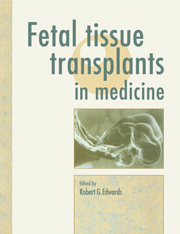Book contents
- Frontmatter
- Contents
- List of contributors
- Preface
- 1 Differentiation and transplantation of embryonic cells in mammals
- 2 Organogenesis and central nervous system development
- 3 Experimental human hematopoiesis in immunodeficient SCID mice engrafted with fetal blood-forming organs
- 4 Ontogeny of human T- and B-cell immunity
- 5 The procurement of human fetal tissues for clinical transplantation. Practice and problems
- 6 Transplantation of fetal haemopoietic and lymphopoietic cells in humans, with special reference to in utero transplantation
- 7 The biology of fetal brain tissue grafts: from mouse to man
- 8 Clinical results of transplanting fetal pancreas
- 9 The suitability of fetal and infantile donors for corneal transplantation
- 10 Transplantation of ovaries and testes
- 11 Cell grafting and gene therapy in metabolic diseases
- 12 The low temperature preservation of fetal cells
- 13 Law and ethics of transplanting fetal tissue
- Appendix: Code of practice on the use of fetuses and fetal material in research and treatment
- Brief bibliography on various aspects of transplanting fetal 337 tissue
- Index
10 - Transplantation of ovaries and testes
- Frontmatter
- Contents
- List of contributors
- Preface
- 1 Differentiation and transplantation of embryonic cells in mammals
- 2 Organogenesis and central nervous system development
- 3 Experimental human hematopoiesis in immunodeficient SCID mice engrafted with fetal blood-forming organs
- 4 Ontogeny of human T- and B-cell immunity
- 5 The procurement of human fetal tissues for clinical transplantation. Practice and problems
- 6 Transplantation of fetal haemopoietic and lymphopoietic cells in humans, with special reference to in utero transplantation
- 7 The biology of fetal brain tissue grafts: from mouse to man
- 8 Clinical results of transplanting fetal pancreas
- 9 The suitability of fetal and infantile donors for corneal transplantation
- 10 Transplantation of ovaries and testes
- 11 Cell grafting and gene therapy in metabolic diseases
- 12 The low temperature preservation of fetal cells
- 13 Law and ethics of transplanting fetal tissue
- Appendix: Code of practice on the use of fetuses and fetal material in research and treatment
- Brief bibliography on various aspects of transplanting fetal 337 tissue
- Index
Summary
FEW SUBJECTS IN EXPERIMENTAL SURGERY have attracted as much public interest or professional controversy as the transplantation of testes and ovaries. At one time hailed as a cure-all for old age, clinical transplantation of gonads was eventually overtaken by advances in chemical endocrinology and transplantation biology and is now regarded mainly as one of the blind alleys of science. The legacies of the so-called rejuvenators have effectively smothered further consideration of transplantation as a potential treatment for hypogonadism.
The first authenticated record of gonadal transplantation is attributed to an eighteenth century Scottish anatomist and surgeon, John Hunter, who grafted chicken testes and ovaries to the body cavity of hosts of either the same or opposite sex. Full details of this work have not survived and it is difficult to evaluate his claims but, since he used allografts, it seems doubtful that he could have been successful. Persistent scar tissue or hypertrophy of host gonads that were incompletely extirpated may explain his claims to success. Such dangers of misinterpretation can account for many false positive findings in a later era and for much of the confusion that followed.
It is the Gottingen biologist, Berthold (1849), who should be credited with the first successful testicular transplants, since, by using autografts, he luckily avoided the risk of rejection. When he replaced the testes of capons in their own body cavity he found that the growth of comb, plumage and courting behaviour, all of which are androgen dependent, were maintained. The transplantation of ovaries was pioneered in France by Bert (1865), but several decades passed until interest in either technique became widespread.
The turn of the century signalled an explosion of interest in gonadal transplantation. One causal factor was the dawning of the new science of endocrinology and the opportunities that transplantation offered for experimentally testing hormone secretion and action. Knauer (1896) autotransplanted rabbit ovaries to the broad ligament and peritoneal cavity and obtained evidence of normal function, including ovulation and prevention of uterine atrophy. Like most of his contemporaries, he regarded allografting as potentially successful, but failed to provide any convincing evidence to support this assumption. The first investigator to transplant fetal ovarian tissue was Foa in 1900. He made the important discovery that immature organs undergo accelerated maturation in an adult environment.
- Type
- Chapter
- Information
- Fetal Tissue Transplants in Medicine , pp. 253 - 280Publisher: Cambridge University PressPrint publication year: 1992



